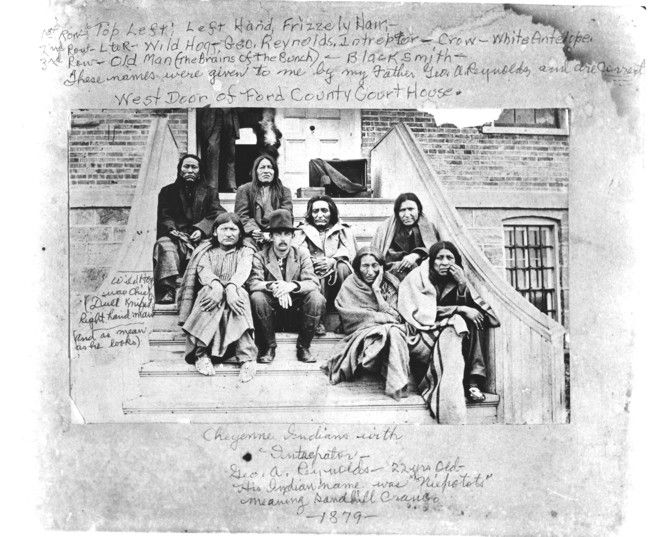In Dull Knife’s Wake
The True Story of the Northern Cheyenne Exodus of 1878
By Vernon R. Maddux & Albert Glenn Maddux
BOOK REVIEW By Nancy Ohnick
When I saw the colorful cover of this soft-cover book on the shelf of a museum book store I was immediately drawn to it. Having roots in Meade County I recognized the name of the Cheyenne chief, Dull Knife, and I had always wondered about the details of the “escape” of this chief and his people from the reservation that had been created for them in Oklahoma.
Like a lot of Americans I have mixed feelings about the plight of Native Americans and the way they were treated when settlement came to this part of the country. Could have it been handled better? Probably. But thankfully the authors of this book do not debate that question, but lay out the facts of the incident without bias, telling both sides and using records from everyone involved, Cheyenne, settlers, soldiers and cattlemen to compile their data.
This incident happened as the southern-most Kansas counties of Clark, Meade, and Seward were starting to attract “settlers.” The buffalo, the main food source of the Cheyenne, had been all but eradicated in this area and the days of the vast open range were numbered. Dodge City was still a popular destination for cattle drives from Texas as the railroad had not yet been built to the southwest. The Cheyenne had been driven from their native hunting grounds and placed on a reservation called Darlington, to the south of the Canadian River in what is now the middle of Oklahoma.
I was surprised to learn that even though this incident is credited to Dull Knife as the chief of this band of Cheyenne, the chief was by this time old and really played a subordinate role in the decisions and organization of the escape. Wild Hog and Little Wolf were the most influential leaders in the breakout from Darlington, and their objective seemed to be only to return to familiar territory of northwest Nebraska and northeast Wyoming.
As we read through the pages of this book we follow the band of 346 Cheyenne from their escape from Darlington on September 10, 1878, to their eventual capture in northwest Nebraska on October 25. The text details the hardships of both the fleeing Cheyenne and the soldiers that chased them north through Oklahoma, Kansas and Nebraska. Both sides experienced challenging weather, hunger and physical exhaustion. Many settlers in the wake of this tribe were terrorized… men and boys were killed… women and girls were tortured, raped and humiliated.
The Cheyenne were captured and placed at Ft. Robinson located in northwest Nebraska. In January of 1879, however, they escaped from their barracks and the chase was on again. Dull Knife and his wife and two daughters managed to escape by hiding in a cave for four days, then heading out in the opposite direction of the rest of the tribe. This small group reached Pine Ridge reservation in southern most South Dakota eighteen days later, starving and exhausted.
Of the re-captured Cheyenne, seven men which included Wild Hog were sent to Dodge City to stand trial. The only murder the prosecution had enough evidence for was the killing of a mail carrier, which took place in Meade County early in the exodus of the tribe. The defense was granted a change in venue and the trial took place in Douglas County. The reader is left unclear as to the outcome of the trial, but eventually the Northern Cheyenne were given their own reservation in their native territory in Montana.
The author explains the politics involved in all corners of the nation in relation to the fate of Dull Knife’s Cheyenne.
I found this book easy to read if a little disconnected. In telling each side from every angle the author sometimes seems repetitive, but then again the reader gets a complete picture of events. I didn’t wade through all the footnotes at the end of each chapter, but now I find myself going back to them to investigate parts of the story further. The book has a bibliography and a good index. I found it a good reference and it will definitely be a treasured part of my history library. Unfortunately this book is now out of print.
More on the raid in Meade County:
(this from Sullivan's "A History of Meade County Kansas")
The first town with which Meade County was threatened was located on Section 16, Township 31, Range 28. “Cap.” French was a surveyor and locator; in the summer of 1878 he located two parties on this section, and in conjunction with them he formed the plan of establishing a city at that place, to be called Meade City. A little store was put up, a few other buildings were erected from time to time, a post office was secured, but the town failed to grow to any appreciable extent, and was abandoned about 1884.
A well-authenticated story is told concerning an adventure of Cap. French during the Indian raid in the fall of 1878. A band of Indians came to Meade City, and, noticing a grindstone, they compelled French to turn it while they sharpened their knives. It was an unpleasant task for him, as he fully expected that when the knives were all sharpened some Indian would test the edge of his instrument on his scalp. However, he was agreeably surprised when they departed without molesting him further. A short distance away, however, they killed a freighter and took possession of his outfit.
Another story in connection with this Indian raid is, that at a ranch house, either in Meade or Clark County, a large quantity of dried apples was secured, of which the Indians ate greedily without subjecting the fruit to the process of cooking. They proceeded on their way toward Meade City, but before reaching that point one of the squaws, having drunk profusely, discovered that dried apples and artesian water do not constitute a proper combination, and died in great agony. She was buried in a small ravine, the body being placed in a ditch washed out by drainage-water and covered loosely with earth. The body was soon exposed, and about a year afterwards it was found by Oliver Norman. The bones were not intact, and Mr. Norman secured the skull, desiring it as a specimen of Indian anatomy. As portions of the skin still adhered to the bones he hung the skull in a tree for further “curing.” While it remained in this tree some eastern tourists observed it, and reported to the eastern press the discovery of a strange tribe of savages who disposed of their dead by depositing the bodies in the branches of trees.

